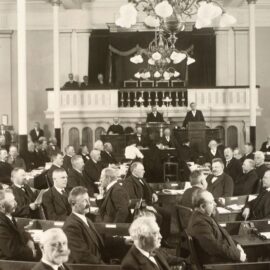

This article is an excerpt from the Shortform book guide to "Business Adventures" by John Brooks. Shortform has the world's best summaries and analyses of books you should be reading.
Like this article? Sign up for a free trial here .
Where can panic on Wall Street lead? What’s a “flash crash”?
In his essays on Wall Street, John Brooks discusses how letting gut reactions override logical thinking can lead to dire results. He uses the 1962 stock market crash as an example.
Continue reading to learn about this incident and what it teaches us about economics and human behavior.
The 1962 Stock Market Crash
Brooks’s first essay illustrates how emotions can drive market behavior, making the stock market inherently unpredictable.
He writes that, on May 28, 1962, the stock market saw a sharp drop reminiscent of the crash of 1929, leading to widespread panic on Wall Street. Fortunately, the crash didn’t last for long and the market recovered within days. (Shortform note: This is known as a “flash crash”—a steep, rapid decline in stock prices over a very short period of time. While the 1962 flash crash played out over a few days, more recent flash crashes have occurred in a matter of minutes. For example, the 2010 flash crash lasted for only a quarter of an hour.)
Pundits tried to determine what caused the 1962 stock market crash, since it happened during a healthy economic period. They floated many theories, but Brooks posits that a key factor was the ticker tape that recorded every transaction. Unable to keep up with the unusually high volume of transactions on May 28, the tape reflected information that was delayed for over an hour—a far cry from the normal delay of just two to three minutes. This meant that investors weren’t getting numbers in real time, which set off their alarm bells. Seeing that stock prices were steadily going down, they assumed the worst and went on a selling spree. This, in turn, led to a further drop in prices.
(Shortform note: Behavioral finance can explain the panic-selling that happens during a market downturn. In A Random Walk Down Wall Street, Burton Malkiel writes that people are generally averse to loss and can fall prey to groupthink—a phenomenon wherein people come to a consensus and make irrational decisions as a unit.)
Beyond outdated technology and human irrationality, Brooks says the real reasons for the flash crash are unknowable, and thus, another one could happen again. (Shortform note: For this reason, billionaire investor Ray Dalio believes that it’s important to study history. In Principles, he writes that every situation has happened before, so knowing how events played out in the past allows you to systematize decision-making. By mapping out contingency plans for various scenarios, you prevent yourself from succumbing to irrational impulses whenever an unforeseen event arises.)

———End of Preview———
Like what you just read? Read the rest of the world's best book summary and analysis of John Brooks's "Business Adventures" at Shortform .
Here's what you'll find in our full Business Adventures summary :
- A collection of essays about the unpredictability of corporations and Wall Street
- How businesses and economies can rise and fall based on people’s behavior
- A look at the major events that shaped the financial world as we know it






